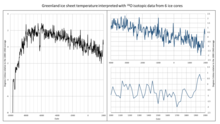Iron Age Cold Epoch
The Iron Age Cold Epoch (also referred to as Iron Age climate pessimum or Iron Age neoglaciation) was a period of unusually cold climate in the North Atlantic region, lasting from about 900 BC to about 300 BC, with an especially cold wave in 450 BC during the expansion of ancient Greece. It was followed by the Roman Warm Period (250 BC – 400 AD).

Greenland ice sheet temperatures interpreted with 18O isotope from 6 ice cores (Vinther, B., et al., 2009)
References
- Gribbin, John; Lamb, H. H. (1978). "Climatic change in historical times". In Gribbin, J. (ed.). Climatic change. Cambridge: Cambridge University Press. pp. 68–82. ISBN 0-521-21594-3.
- Plunkett, Gill; Swindles, Graeme T. (2008). "Determining the Sun's influence on Lateglacial and Holocene climates: a focus on climate response to centennial-scale solar forcing at 2800 cal. BP". Quaternary Science Reviews. 27 (1–2): 175–184. Bibcode:2008QSRv...27..175P. doi:10.1016/j.quascirev.2007.01.015.
- Swindles, Graeme T.; Plunkett, Gill; Roe, Helen M. (2007). "A delayed climatic response to solar forcing at 2800 cal. BP: multiproxy evidence from three Irish peatlands". The Holocene. 17 (2): 177–182. Bibcode:2007Holoc..17..177S. doi:10.1177/0959683607075830.
- Van Geel, B.; Buurman, J.; Waterbolk, H. T. (1998). "Archaeological and palaeoecological indications of an abrupt climate change in The Netherlands, and evidence for climatological teleconnections around 2650 BP". Journal of Quaternary Science. 11 (6): 451–460. Bibcode:1996JQS....11..451V. doi:10.1002/(SICI)1099-1417(199611/12)11:6<451::AID-JQS275>3.0.CO;2-9. Archived from the original on 2012-12-18.
This article is issued from Wikipedia. The text is licensed under Creative Commons - Attribution - Sharealike. Additional terms may apply for the media files.